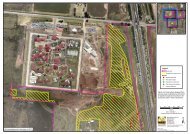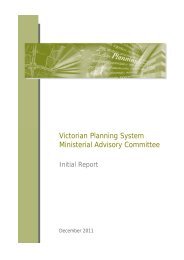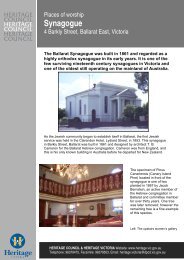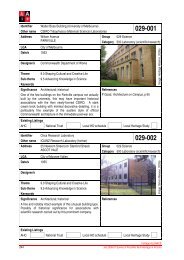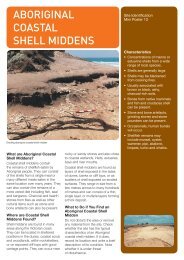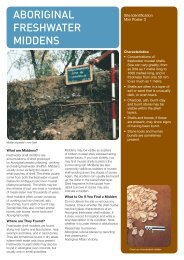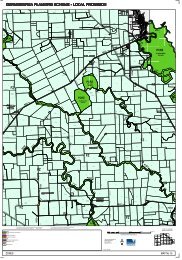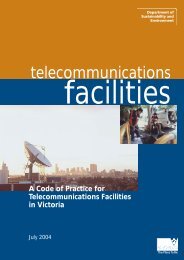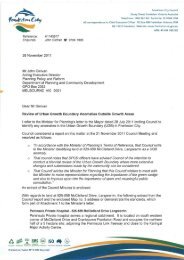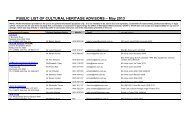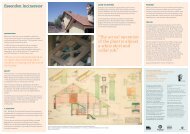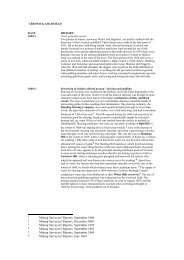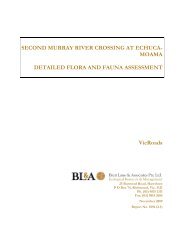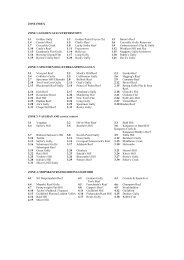Tram history - Chapter 6 - Part 1
Tram history - Chapter 6 - Part 1
Tram history - Chapter 6 - Part 1
Create successful ePaper yourself
Turn your PDF publications into a flip-book with our unique Google optimized e-Paper software.
6.0 DESCIPTION OF HISTORICAL ELEMENTS<br />
6.1 <strong>Tram</strong>way technology (Theme 5.2 manufacture)<br />
6.1.1 Main layout of the tram system<br />
Melbourne Metropolitan <strong>Tram</strong>way Heritage Study, Gary Vines<br />
Evidence of the late nineteenth century and early 20 th century engineering works of Melbourne’s<br />
tramway system abounds in the current extent of routes along Melbourne’s roads. The tracks,<br />
overhead wires and trams are the most obvious and visible evidence of the continuing<br />
importance of tramways. However, the fabric which has direct and tangible associations with the<br />
creation and development of the tramways is less evident, with most of the track network having<br />
undergone regular replacement. All but a handful of vehicles on the system are of relatively<br />
modern construction, with 90% of rolling stock being less than 25 years old.<br />
In the case of buildings, however, the situation is reversed, most of the current depots,<br />
administrative buildings, workshops, substations and the more substantial shelters date from<br />
before the middle of the twentieth century, and in many cases to the beginnings of the electric<br />
tramways. Other buildings, no longer employed as part of the operating system also survive,<br />
including a number of Cable <strong>Tram</strong> engine houses, and disused depot buildings.<br />
A detailed inventory is provided of surviving tramway places, rolling stock and collections, but<br />
here they are summarised.<br />
6.1.1.1 Cable <strong>Tram</strong>way System<br />
Of the previous 12 engine houses, only five survive relatively intact, (Queensbury Street North<br />
Melbourne, Rathdown Street North Carlton, Gertrude Street Fitzroy, Brunswick Road<br />
Brunswick, and High Street Northcote), while two are only facades (City Road Port Melbourne<br />
and Johnston Street Fitzroy), one only retains a section of outer wall (Bridge Rd Richmond) and<br />
three have been extensively modified (Wellington Street Windsor, cnr. Chapel Street & Toorak<br />
Road South Yarra and cnr. St Kilda Road & Bromby Street South Yarra). Two have been<br />
completely demolished (Sydney Rd Brunswick, and cnr. Victoria Parade and Brunswick Rd<br />
Fitzroy although both may have surviving underfloor archaeological remains.<br />
There were 16 cable car barns on the system, but few survive. Northcote was unusual in having<br />
the shed and engine house part of the same structure, with a similar arrangement at Rathdowne<br />
Street. There is a separate car shed building at the Toorak Engine house, detached and with its<br />
own entrance which may be the only relatively intact car barn. The facade of the Richmond car<br />
barn has been incorporated into a new building, but the shedding is gone. The Port Melbourne<br />
Car Shed of 1890 is possibly the most intact car shed of Melbourne's former cable tram system.<br />
It apparently contains the sole surviving in situ remnants of tracks of the cable tram system.<br />
The Nicholson Street car workshops were converted to the electric then bus depot, but a pitched<br />
shed may still relate to the original structure. The most prominent building apart from the engine<br />
houses is the MT&OCo office in Bourke Street.<br />
There is no known visible cable trackwork in Melbourne. Although an extensive section of<br />
buried track and cable tunnel was recently found in Abbotsford Street. The section of track at the<br />
west end of Bourke Street was removed about 15 years ago. Of the other Heritage Inventory<br />
listed places where trackwork may survive, the demolished Brunswick Street engine house is one<br />
B I O S I S R E S E A R C H 1 2 5
Melbourne Metropolitan <strong>Tram</strong>way Heritage Study, Gary Vines<br />
of the more likely to reveal archaeological evidence in the form of engine flywheel and cable<br />
tensioner pits and sheave or wheel pits in the roadway. 209<br />
Figure 95: Cable tram slot and track at western end of Bourke Street c 1988 210<br />
6.1.1.2 Electric <strong>Tram</strong>way System<br />
There were 15 electric tram depots on the system at one time or another but not all in operation<br />
at the same time. Most of these survive in some form. Some of the earliest large depots from the<br />
<strong>Tram</strong>way Trust period, Essendon, Malvern, Hawthorn Camberwell, are intact. Some smaller<br />
depots such as Hannah Street South Melbourne, East Coburg, Footscray and Thornbury (also<br />
known as Preston or West Preston) have been demolished. The later depots, Glenhuntly, East<br />
Preston, Brunswick, Kew, are substantial and in some cases architecturally elaborate and<br />
demonstrate the period of expansion of the system in the mid 20 th century under the MMTB.<br />
There is very little remaining from the Victorian Railways trams, with a shed at Sandringham<br />
possibly the only substantial structure.<br />
different names for this depot, the one opposite Preston workshops, I have seen Preston and West<br />
Preston and Thornbury, we need to be consistent - Thornbury is the better one I think.<br />
There are potentially archaeological remains of various components of the system including the<br />
site of the Doncaster tram engine house, former cable tram engine house subfloor areas<br />
(Brunswick, South Melbourne) and sections of track where later electric tram conversions did<br />
not require them to be lifted (such as Rathdowne Street). These sites could add to understanding<br />
and interpretation, but these are mainly unrealised, apart from the section of cable track and<br />
tunnel in Abbotsford Street.<br />
209 Lancelloti, Lucia, & Green, Robert, n.d. “The Fitzroy Cable <strong>Tram</strong> engine House (And part of the road reserve),<br />
81-89 and part of 93-103 Victoria Parade Fitzroy: the identification of potential Archaeological Remains.”<br />
Unpublished report Heritage Victoria; Ellis, A, 2007, Archaeological recording: Cable <strong>Tram</strong> Tracks Abbotsford<br />
Street, North Melbourne. report prepared for Heritage Victoria June 2007.<br />
210 http://vhd.heritage.vic.gov.au/#large_image_carousel:64418:0<br />
B I O S I S R E S E A R C H 1 2 6
Melbourne Metropolitan <strong>Tram</strong>way Heritage Study, Gary Vines<br />
Figure 96: Melbourne’s <strong>Tram</strong>ways at greatest extent of cable lines & prior to the formation of MMTB<br />
B I O S I S R E S E A R C H 1 2 7
Figure 97: Melbourne’s <strong>Tram</strong>ways at its present extent<br />
Melbourne Metropolitan <strong>Tram</strong>way Heritage Study, Gary Vines<br />
B I O S I S R E S E A R C H 1 2 8
6.2 Rolling Stock, motive power and controllers<br />
Melbourne Metropolitan <strong>Tram</strong>way Heritage Study, Gary Vines<br />
Melbourne’s <strong>Tram</strong>ways are recognised in the public mind as much for the tramcars as any other<br />
element. The trams can be considered moveable cultural heritage, and in fact are best appreciated<br />
when moving. When recognisably historic trams are in use, they take on the character of an<br />
historic place, but one found in a different location each time. Therefore, seeing a W class in<br />
normal operation might recall an image of historical Melbourne, even if the context is a busy<br />
modern roadway amidst contemporary traffic and streetscapes.<br />
What makes a tram an historic object (or even an historic place when come across in static<br />
display) is the recognition in its shape, style, finishes, details and character, something from the<br />
past. <strong>Tram</strong> design in Melbourne, prior to the introduction of the Z class, had more relationship to<br />
coach building, than modern motor vehicles (although other cities such as Adelaide and Brisbane<br />
introduced modernistic streamlines metal bodied trams on their systems from the 1930s).<br />
The visibly distinctive design of trams was the result of a tradition going back to 17 th century<br />
carriage building design. This included a shape which curved outwards gracefully from the<br />
narrower frames (probably intended to provide a harmonious transition), panelled frames and<br />
doors (where fitted) organic shapes in brackets and ironwork reflecting the traditional<br />
blacksmithing skills, decorative glass panels and inclusion of clerestory windows in the roof, and<br />
finely-finished polished timber, painted colour schemes, decorative linework, and company<br />
monograms.<br />
The Green and Cream of the later MMTB livery was introduced in 1925 (supposedly to<br />
complement Melbourne's tree-lined boulevards). This colour scheme has become such an<br />
intrinsic sight in Melbourne tram travellers imagination, that there was an outcry when it was<br />
changed, and continues to be an issue with some, even spawning a “Melbourne <strong>Tram</strong>s Should Be<br />
Green!” Facebook group.<br />
The earliest trams probably took their design cues from railway carriages (which themselves<br />
developed from British stage coach designs). Early examples were imported, and soon locally<br />
manufactured (probably still closely following overseas patterns). Brill and Birney in the US was<br />
the major early provider of chassis and running gear, while James Moore & Sons Pty Ltd, a<br />
Melbourne timber joinery company and Duncan & Fraser of Adelaide, ere the major assemblers<br />
and coachbuilders until the MMTB commenced its own manufacture in Preston workshops.<br />
6.2.1 Horse <strong>Tram</strong>s<br />
The horse trams used in Melbourne bear a strong physical and historical relationship with the<br />
cable trams introduced by Clapp in the 1880s. This relationship can be seen in the model used<br />
for promoting the MT&OCo at the Melbourne Exhibition, which was exhibited initially as a<br />
horse tramcar, but later displayed with a cable tram dummy car to demonstrate the appearance of<br />
the rolling stock for the new system. The horse trams tended to be small and simple, built on a<br />
four wheel truck. 211 The cable trailer was based on the design of Stephenson of New York - a<br />
very common design, used in London as well. Equipment was confined to wheel or lever<br />
operated brakes, a bell, and shafts and harness, similar to that employed for centuries on horsedrawn<br />
wagons and carriages.<br />
211 "truck" generally refers to a four wheel tram or single bogie.<br />
B I O S I S R E S E A R C H 1 2 9
Melbourne Metropolitan <strong>Tram</strong>way Heritage Study, Gary Vines<br />
Figure 98 Melbourne <strong>Tram</strong>way and Omnibus Co Ltd. <strong>Tram</strong>car model from Melbourne Centennial Exhibition –<br />
1888, exhibit No. 1152<br />
6.2.2 Cable <strong>Tram</strong>s<br />
While little of the track work, cabling or drive engines and only a few examples of rolling stock<br />
from the cable era survive, the distinctive technology of cable trams is still evident in the few<br />
components. In Abbotsford Street North Melbourne, a section of abandoned and buried cable<br />
track and tunnel was unearthed recently. 212 The grip mechanism was the key patent to making<br />
the system work, employing a geared lever which closes and opens a jaw set over the cable, to<br />
alternately drive and slow the tram. Brakes were hand lever operated friction type with curved<br />
shoes working against the wheels, or track brakes, where a timber block is pressed down directly<br />
on the track between the wheels.<br />
Of the several hundred cable tram dummies and trailers, only a handful have survived, the<br />
original No 1 set was set aside six months before the final closure of the last line and donated to<br />
the Science Museum (now Museum Victoria). It was restored in 1975 at the Preston Workshops,<br />
and displayed for many years outside the Russel Street museum entrance. 213<br />
Surviving cable trams include grip cars (Dummies) No 1 held by Museum Victoria. No. 28, and<br />
No. 436, Melbourne cable grip car is also held by the Powerhouse Museum Sydney. Trailers<br />
have fared better with Bogie cars #190, 192, 475, 485 and Standard cars #1, 256, 290, 299, 462,<br />
469, 586 all held by the TMSV Bylands. Replica Trailer No 95 with Grip car powered by petrol<br />
motor are in used in Portland. A replica trailer and dummy car were built at Malvern Depot by<br />
trainees and are owned by the TMSV but on loan to the Hawthorn <strong>Tram</strong> Museum. ,<br />
A cable grip mechanism is held at Scienceworks and another mechanism is believed to be held<br />
in the Powerhouse Museum Sydney, but may be a different model used on the Sydney cable<br />
trams.<br />
212 Victorian Heritage Inventory H7822-0981 and VHR H0988.<br />
213 A Twentyman, The Melbourne Cable <strong>Tram</strong> Network, Trolley Wire October 1975, p.13<br />
B I O S I S R E S E A R C H 1 3 0
Figure 99: Cable <strong>Tram</strong> Grip mechanism<br />
6.2.3 P&MTT cars<br />
Melbourne Metropolitan <strong>Tram</strong>way Heritage Study, Gary Vines<br />
The P&MTT operated a variety of bogie tramcars, commencing in 1910 with 13 single truck<br />
California combination cars built in Adelaide by Duncan & Fraser. These were followed by<br />
seven more of the same type and then in 1912-14, several single-bogie drop-end open<br />
California combination cars, and maximum traction bogie drop centre & drop end combination<br />
cars also built by Duncan and Fraser.<br />
B I O S I S R E S E A R C H 1 3 1
No<br />
Figure 100: Dandenong Road combination car blueprint. 214<br />
Melbourne Metropolitan <strong>Tram</strong>way Heritage Study, Gary Vines<br />
There then followed further series of tramcars built by the Meadowbank Manufacturing<br />
Company, by the PMTT’s own Coldblo Road Workshops and by James Moore & Sons<br />
modified. These included innovations such as air brakes, some unusual two-bogie combination<br />
cars with the saloon at one end and crossbench seating and six bogie drop-centre tramcars fitted<br />
with equal-wheeled Brill 77E trucks, four motors and air brakes. These last were delivered after<br />
the MMTB takeover and influenced later designs forming the basis for W class. Also ordered<br />
were the L-class trams but these only entered service after MMTB takeover in 1920. They were<br />
the widest trams, and the first with four motors. They were very successful and formed a model<br />
for the design of the MMTB W class.<br />
Preserved P&MTT trams include C 26 (now Bendigo Trust No 5.), C 35 (now Ballarat <strong>Tram</strong><br />
Museum No. 40), E 40 (now at TMSV Bylands), E 41 (now Ballarat <strong>Tram</strong> Museum No.38), E<br />
42 (now Ballarat <strong>Tram</strong> Museum No. 39), E 44 (now Bendigo Trust 44), E45 (now Bendigo Trust<br />
no. 18), and F 46 (P&MTT 36 now at TMSV Bylands). F46 and G53 are held by the <strong>Tram</strong>way<br />
Museum of Victoria for future restoration. A summary of trams operated on the PMTT system is<br />
available on the Hawthorn <strong>Tram</strong> Museum website. 215<br />
MMTB<br />
class<br />
1-20 A 1910-<br />
11<br />
Built Car builder Description Seats Truck Control Motors Weight<br />
(tons)<br />
Duncan &<br />
Fraser<br />
21-24 O 1912 Duncan &<br />
Fraser<br />
25-35 C 1913 Duncan &<br />
Fraser<br />
36 D 1914 Duncan &<br />
Fraser<br />
Single truck drop-end California<br />
combination<br />
Maximum traction bogie closed<br />
combination (sold to HTT 1916)<br />
Maximum traction bogie drop<br />
centre drop end combination.<br />
Motors upgraded in 1918-20 to 2 x<br />
65hp (GE 201G)<br />
Maximum traction bogie drop<br />
centre drop end combination (as for<br />
36 Brill<br />
21E<br />
54 Brill<br />
22E<br />
56 Brill<br />
22E<br />
56 Brill<br />
22E<br />
214 Stonnington Library http://stonlib.stonnington.vic.gov.au/cgibin/spydus.exe/ENQ/PIC/BIBENQ?IRN=6480955&FMT=PA<br />
215 Russell Jones. 2008, ‘PMTT tramcar fleet’, Friends of Hawthorn <strong>Tram</strong> Depot,<br />
.http://www.hawthorntramdepot.org.au/papers/pmtt-01.htm<br />
WH T1F 2 x 33hp<br />
WH 205<br />
GE<br />
B23D<br />
GE<br />
B23D<br />
GE<br />
B23D<br />
2 x 50hp<br />
GE 202<br />
2 x 50hp<br />
GE 202<br />
2 x 65hp<br />
GE<br />
B I O S I S R E S E A R C H 1 3 2<br />
Disposal<br />
11.9 1926-31<br />
16.3 1927<br />
17.3 1935-55<br />
17.3 1940
No<br />
MMTB<br />
class<br />
Melbourne Metropolitan <strong>Tram</strong>way Heritage Study, Gary Vines<br />
Built Car builder Description Seats Truck Control Motors Weight<br />
(tons)<br />
37-45 E 1914 Duncan &<br />
Fraser<br />
46-47 F 1912 Duncan &<br />
Fraser<br />
48-53 G 1913 Duncan &<br />
Fraser<br />
54-63 H 1913 Duncan &<br />
Fraser<br />
64-83 J 1915-<br />
16<br />
21-24<br />
84-85<br />
B 1916-<br />
17<br />
86-91 B 1917-<br />
18<br />
92-100 K 1919-<br />
20<br />
Meadowbank<br />
Manufacturing<br />
Company<br />
PMTT Coldblo<br />
Rd Workshops<br />
PMTT Coldblo<br />
Rd Workshops<br />
James Moore &<br />
Sons<br />
101-105 L 1921 James Moore &<br />
Sons<br />
106 L 1921 James Moore &<br />
Sons<br />
– – 1915 PMTT Coldblo<br />
Rd Workshops<br />
Table 6: <strong>Tram</strong>s of the PMTT<br />
6.2.4 Victorian Railways Cars<br />
37-45 but modified in 1915 for<br />
conductresses)<br />
Maximum traction bogie drop<br />
centre drop end combination.<br />
Motors upgraded in 1917-19 to 2 x<br />
65 hp (GE 201G)<br />
Single truck straight sill semi-open<br />
cross-bench (clerestory roof) -<br />
modified to combination car with<br />
reduced seating. No 46 originally<br />
numbered 36.<br />
Single truck straight sill semi-open<br />
cross-bench (vent arch roof) -<br />
modified in 1918 to combination<br />
car with reduced seating<br />
Single truck drop-end California<br />
combination<br />
Single truck drop-end California<br />
combination<br />
Single truck drop-end California<br />
combination<br />
Single truck drop-end California<br />
combination<br />
Single truck straight sill California<br />
combination<br />
Four motor bogie drop centre<br />
combination<br />
Four motor bogie drop centre<br />
combination<br />
Works car fitted with rail cleaning<br />
and flushing equipment. Numbered<br />
3A by MMTB (1927), then 6<br />
(1934).<br />
56 Brill<br />
22E<br />
GE<br />
B23D<br />
B I O S I S R E S E A R C H 1 3 3<br />
52/3<br />
6<br />
52/3<br />
4<br />
Brill<br />
21E<br />
Brill<br />
21E<br />
36 Brill<br />
21E<br />
36 Brill<br />
21E<br />
36 Brill<br />
21E<br />
36 Brill<br />
21E<br />
36 Brill<br />
77E<br />
56 Brill<br />
77E<br />
56 Brill<br />
77E<br />
– Brill<br />
21E<br />
201G<br />
2 x 50hp<br />
GE 202<br />
WH T1F 2 x 33hp<br />
WH 205<br />
AEG 2 x 44hp<br />
U140<br />
AEG 2 x 44hp<br />
U140<br />
AEG 2 x 44hp<br />
U140<br />
GE<br />
B23D<br />
GE<br />
B23D<br />
GE<br />
B23D<br />
2 x 50hp<br />
GE 202<br />
2 x 50hp<br />
GE 202<br />
2 x 50hp<br />
GE 202<br />
GE 4 x 40hp<br />
K35AA2 GE 247<br />
GE PC5 4 x 40hp<br />
GE 247<br />
WH T1F 2 x 44hp<br />
U140<br />
Disposal<br />
17.3 1943-51<br />
11.3 1929<br />
11.6 1929-32<br />
11.9 1930-31<br />
12.0 1928-31<br />
12.0 1929-31<br />
12.0 1929-31<br />
12.9 1929-36<br />
19.1 1981-82<br />
19.1 1981<br />
11.0 1948<br />
The Victorian Railways used trams of two different gauges the railway gauge of 5 ft 3 inches<br />
and the standard gauge of 4 ft 8 ½ inches. The trams were 4 wheel bogies, but following the loss<br />
of the original fleet in the 1907 fire, 14 replacement trams made at Newport Workshops trams<br />
included 7 California combinations cars (1-7) and seven toastrack trailers (8-14). 9 extra trams<br />
(19-27) built to increase the service were based on the Sydney J class trams, a single truck closed<br />
crossbench design. Twenty air brake equipped bogie drop centre, four motor trams (28-47), the<br />
first in Melbourne, were built at Newport Workshops and put into service in 1918 until 1923.<br />
The last four trams (44-47) were never completed. Twelve of the older trams were regauged and<br />
transferred to Sandringham for the opening of the Black Rock tramway in 1919, while the result<br />
were mostly sold or scrapped. In 1942 three new cars (52-54) of double bogie luxury cars were<br />
built based on the MMTB SW6 design, using some electrical equipment from the uncompleted<br />
cars (44-47). The California cars were withdrawn with the introduction of these new cars, but did<br />
return for some peak services when required until 1956 when they were scrapped. 216<br />
Victorian Railways trams Nos. 20, 34, 41, 48, 49, 52, 53, are preserved in various collections.<br />
216 Victorian Railways - Electric Street Railways (VR <strong>Tram</strong>s),<br />
http://www.vicsig.net/index.php?page=trams§ion=vr
HTT<br />
no.<br />
11-<br />
20<br />
6.2.5 HTT trams<br />
Melbourne Metropolitan <strong>Tram</strong>way Heritage Study, Gary Vines<br />
The Hawthorn <strong>Tram</strong>way Trust fleet initially comprised eight single truck straight sill closed<br />
combination car bodies ordered from James Moore and Sons and assembled at P&MTT. It also<br />
obtained a number of bogie cars. The Melbourne Heritage fleet includes M114/HTT 8 and<br />
P138/HTT 32. Other preserved HTT trams include N119 (Ballarat No. 37), N120, N122, N123,<br />
N126 (Bendigo <strong>Tram</strong>ways) P132 (Ballarat No. 36 at the <strong>Tram</strong>way Museum of Victoria), P133,<br />
(Bendigo No. 25 at the Bendigo <strong>Tram</strong>ways), P137 (Ballarat No. 34 at Australian Electric<br />
Transport Museum), and P138, ( MMTB 138 at the Bendigo <strong>Tram</strong>ways). M class trams 111,<br />
113, 116 and 186/9 are preserved at the Ballarat <strong>Tram</strong>way, while M 185, 187 and 188 are at<br />
Bendigo, 189 in storage), M184 (Ballarat No. 31 at Whiteman Park <strong>Tram</strong>way Museum)<br />
M107 (Bendigo No. 12), M110 (Bendigo No. 6). H55 is awaiting restoration at the <strong>Tram</strong>way<br />
Museum of Victoria and M183 became Ballarat No. 30), and was damaged by fire in a museum<br />
in Oregon, USA. 217<br />
A summary of Hawthorn <strong>Tram</strong>way Trust rolling stock has been compiled from the<br />
No Built Car builder Description Seats Truck Control Motors Weight<br />
(tons)<br />
MMTB<br />
class<br />
N 117-126 1916-<br />
17<br />
Duncan &<br />
Fraser<br />
Maximum Traction bogie, twobogie<br />
drop-centre saloon cars<br />
52 2 x 65hp<br />
GE<br />
201G<br />
36 various 2 x 50<br />
hp<br />
1-10, M 107-116, 1916-<br />
single truck, drop end, open<br />
33-39 183-189 18<br />
California combination cars,<br />
21-24 O 127 - 130 1912 two-bogie trams open crossbench 54 WH T1F 2 x 50hp<br />
GE202<br />
25-32 P 131-138 1916-<br />
17<br />
MBTT<br />
no.<br />
Table 7: <strong>Tram</strong>s of the HTT<br />
6.2.6 MBCTT trams<br />
Duncan &<br />
Fraser<br />
Maximum Traction bogie, twobogie<br />
drop-centre saloon cars,<br />
B I O S I S R E S E A R C H 1 3 4<br />
Disposal<br />
1945-7<br />
1928-30<br />
Sold<br />
1926 to<br />
Adelaide<br />
52 1945-7<br />
The MBTT commenced with 25 combination cars with long saloon, mounted on a Radiax (radial<br />
axle) T-class truck by J.G. Brill of Philadelphia, imported in complete knock-down condition.<br />
The tramway also operated 12 single truck California cars assembled by the Adelaide firm of<br />
Duncan & Fraser, with bodies designed by Struan Robertson. These were the first in Melbourne<br />
to be fitted with air brakes. Six cars were built by Duncan & Fraser with radial truck (Brill<br />
Radiax) long wheelbase in 1916 and another six cars of same design as the initial 12 cars, but<br />
with line breakers in place of circuit breakers, and torpedo type roof ventilators were added in<br />
1918. S164/MBCTT-11, has been preserved by the <strong>Tram</strong>way Museum of Victoria, and is on loan<br />
to the Hawthorn <strong>Tram</strong> Depot. One operating T-class tram, No. 180, belongs to the <strong>Tram</strong>way<br />
Museum of Victoria, is on loan to the Hawthorn <strong>Tram</strong> Depot.<br />
MMTB<br />
class<br />
No Built Car builder Description Seat<br />
s<br />
1-18 S 154-171 1916-<br />
17<br />
Duncan and<br />
Fraser<br />
19-25 T 177 - 182 1917 Duncan and<br />
Fraser<br />
Table 8: <strong>Tram</strong>s of the MBCTT<br />
single truck, drop end, open<br />
California combination cars,<br />
Truck Control Motors Weight<br />
(tons)<br />
36 various 2 x 50<br />
hp<br />
38<br />
/110<br />
217 ‘Melbourne’s <strong>Tram</strong> History http://www.railpage.org.au/tram/c.html<br />
Brill<br />
Radiax<br />
Disposal<br />
1928-30<br />
1962
6.2.7 FNPTT <strong>Tram</strong>s<br />
Melbourne Metropolitan <strong>Tram</strong>way Heritage Study, Gary Vines<br />
The Footscray, Northcote and Preston <strong>Tram</strong>way Trust was not operational prior to the Takeover<br />
by the MMTB, and while trams were ordered for the line and completed in 1920, they did not<br />
have separate FNPTT designations. The MMTB designated the single-truck straight-sill, closed<br />
combination cars R class and were later all re-designated as G-class. <strong>Tram</strong>s were numbered R<br />
151-153, 172-176. They were withdrawn between 1929-36.<br />
6.2.8 NMETL<br />
The North Melbourne Electric <strong>Tram</strong>way and Lighting Co. operated two types of trams from<br />
1906. At the time of the MMTB takeover, these were designated U (1 to 10) and V class (11 to<br />
15), The U class was an enclosed saloon tram while the V was an open toastrack design. Both<br />
employed GEK10, GE K36J controllers and 2 x GE67 34 kW motors and were withdrawn from<br />
1929, with the last out of service by 1944-45. One tram has been preserved, No. 214, at the<br />
Hawthorn <strong>Tram</strong> Depot.<br />
6.2.9 MMTB<br />
The MMTB initially took over the vehicles from the various trusts, but soon found a need for<br />
more trams, and initially ordered single-truck straight-sill closed combination cars (Q-class).<br />
(note codes were rationalised and trams re-classified in 1928). Two Birney Lightweight Safety<br />
Cars were imported from the USA in 1924, along with some experimental one-man operation<br />
saloon tourist cars of the Y-class. The Birney’s were built by Brill and the St Louis Car Co. and<br />
were the last trams to be imported for the Melbourne system. They were single-bogie cars, the<br />
smallest of Melbourne's passenger trams, and intended for driver-only operation on lightly<br />
trafficked lines. Numbered 217 and 218 they were withdrawn in 1957. 217, belongs to the<br />
<strong>Tram</strong>way Museum of Victoria is on loan to the PTC historic fleet at the Hawthorn <strong>Tram</strong> Depot.<br />
The X1 (Nos: 459 – 468) and X2 (Nos: 675 – 680) class series, were introduced in 1928-30 and<br />
were locally-built based on the Birney (X-class) design. Two doorways on each side were<br />
provided. They operated mainly on the Footscray system until it was closed in 1962, although<br />
some operated all over Melbourne in all-night service. The X2 class reverted to a single doorway<br />
on each side. X1 467, is at the <strong>Tram</strong>way Museum of Victoria X2 676, is at the Hawthorn <strong>Tram</strong><br />
Depot and 680, at the <strong>Tram</strong>way Museum of Victoria.<br />
The Q-class trams were built by the MMTB in 1922-23 to similar designs to existing PMTT<br />
trams, in order to quickly increase the number of electric trams in service. Q139, 199 and 197,<br />
are preserved, the last as scrubber car 9W at the Hawthorn <strong>Tram</strong> Depot .<br />
The Y class appears to have been developed as a prototype driver-only tram, although it was<br />
probably not operated that way. It was followed by the Y1 of "Peter Witt" design which was<br />
fitted with a sloping windscreen to avoid the reflections of internal lighting getting in the driver's<br />
eyes. Larger wheels were introduced to improve the ride, and reduce noise. It is possible that this<br />
tram was intended to be the new standard design for Melbourne, but its potential for driver-only<br />
operation meant that union opposition was certain, so development of the W-series (with the<br />
W3) was continued instead.<br />
B I O S I S R E S E A R C H 1 3 5
Melbourne Metropolitan <strong>Tram</strong>way Heritage Study, Gary Vines<br />
Only one Y class was built in 1927 (No. 469), followed by four Y1 trams in 1930 (Nos: 610 –<br />
613). The only Y-class and Y1. 613 are at the Hawthorn <strong>Tram</strong> Depot, while 610 is at Bendigo,<br />
611 stored at the Preston Workshops and 612 is at TMSV Bylands. 218<br />
6.2.10 W Class<br />
Between 1923 and 1956 756 W-class trams were built in eight series to a variety of design<br />
variations, most of which were built at the MMTB's Preston workshops.<br />
The origins of the W can be traced to a small batch of 21 trams built by Duncan & Fraser of<br />
Adelaide for the Prahran & Malvern <strong>Tram</strong>ways Trust (P&MTT) in 1913-14. The early trams<br />
known as drop centre cars had a half open half saloon form, which allowed for faster loading,<br />
but gave some protection to passengers who might be more sensitive, or travelling further. 219<br />
The style seemed most suited to the climate in California and Australia, although toast-rack<br />
styles with all the seats running across the tram and open sides, became common in Sydney. A<br />
new style of tram with an open centre section with lower floor for ease of egress, and an<br />
enclosed saloon at each end appears to have first evolved in Australia, with Melbourne, Brisbane<br />
and Adelaide all developing versions of the drop-centre bogie car during the 1920s, although<br />
trams made by Boon & Co of Christchurch in New Zealand also claim this title. 220<br />
Equipment in the surviving W Class trams still has an archaic appearance, with the electric<br />
control unit housed directly in front of the driver’s knees, and direct coupled levers to operate<br />
both it and the brakes. Older style trams frequently use a simplified form of Westinghouse<br />
railway brake. The brake is applied by allowing compressed air to enter a large brake cylinder<br />
(or cylinders), which pressed brake shoes onto the wheels. A sanding system is used to improve<br />
traction in the west and especially during autumn leaf fall with a floor pedal operation The brake<br />
system is operated by means of a valve. A foot pedal is used to operate the large bell, mounted<br />
directly under the cabin floor, so that the sound is best projected to the front. The crash<br />
worthiness of the front of the W class tram is an issue as the driver has to be placed close to the<br />
front for visibility, and the solid chassis rails offer no opportunities for crumple zones.<br />
Modern trams now use electromagnets to force heavy blocks down onto the track and the latest<br />
designs use disc breaks. These were activated by means of a button or switch, or in some more<br />
recent systems by simply releasing the "dead man's handles" while the vehicle is moving.<br />
Modern trams also use stub axles rather than axles connecting both wheels to give low floor<br />
technology, while they vehicles are quite different technically with complex wiring, electronics<br />
and monitors, cameras and sonic bells.<br />
Magnetic Brakes were fitted to the City Circle trams in 2001 and different air operated brake<br />
systems, in order to deal with over-run issues. With the progressive replacement of W class<br />
trams, selected examples have been retained as part of the ‘ready reserve fleet’, while some<br />
special examples have been placed in the heritage collection at Hawthorn Depot. The heritage<br />
fleet comprises 6 W class trams (W 380, W1 431, W2 325, W2 510, W5 774, W7 1040).<br />
218 Y1 Class, VicSig, http://www.vicsig.net/index.php?page=trams&class=Y1<br />
219 Matthew Churchward , W-Class <strong>Tram</strong>s, http://www.emelbourne.net.au/biogs/EM01571b.htm<br />
220 Australian Heritage commission, Linking a Nation, <strong>Chapter</strong> 6: Transport and Making Cities, 1850-70,<br />
http://www.environment.gov.au/heritage/ahc/publications/commission/books/linking-a-nation/chapter-<br />
6.html#electric-tramcar, also pers com Warren Doubleday; <strong>Tram</strong> and light-rail transit systems, Wikipedia,<br />
http://en.wikipedia.org/wiki/<strong>Tram</strong>_and_light-rail_transit_systems<br />
B I O S I S R E S E A R C H 1 3 6
Melbourne Metropolitan <strong>Tram</strong>way Heritage Study, Gary Vines<br />
With the progressive replacement of the W class trams, selected examples have been retained in<br />
the heritage fleet and conserved at the Hawthorn Depot., or in the ready reserve fleet for possible<br />
emergency use. The gutted ‘Henderson Springs’ trams are possibly the more exceptional of the<br />
remaining mothballed trams, that might be further interest for technical and historical value. 221<br />
6.2.11 Prototypes (PCC980 and 1041)<br />
Almost continuous development and refinement of the W Class was undertaken up to the 1950s.<br />
However, a period of stagnation then ensued that meant little new design was initiated.<br />
In 1938 the MMTB obtained the Australian licence to import PCC patented technology and<br />
proposed to import a PCC tramcar for evaluation in Melbourne as part of its plans to modernise.<br />
PCC stands for Presidents Conference Committee, a design committee formed from the 1929<br />
‘Electric Railway Presidents’ Conference Committee’ as an attempt to fend off competition from<br />
busses and automobiles, with a standardised tramcar design. This would employ most efficient<br />
and comfortable design providing smooth acceleration and braking, rubber mountings and<br />
springs and hypoid gears to minimise noise, vibration and rattle, and enclosed saloons with good<br />
heating and ventilation.<br />
In 1949 PCC trucks and control equipment were imported, instead of a complete PCC due to<br />
import restriction and a hybrid car was produced with a locally made, modified SW6 body<br />
mounted on St Louis B3 trucks powered by General Electric controls. The floor in the dropcentre<br />
section of the tram had to be raised to fit the PCC equipment. The full acceleration and<br />
deceleration capabilities of the equipment were disabled, as they were considered a hazard on a<br />
system where no other tram possessed them. So the tram had neither the styling nor the<br />
performance of the American PCCs. 222<br />
This was to be the prototype for tramcars built for the conversion of Bourke Street bus routes to<br />
electric tram routes, but this did not eventuate due to financial constraints. However, because the<br />
government of the day prevented the board from obtaining any new trams no further PCC trams<br />
were built –although standard Ws continued to be built up to 1956 when the last, W7-1040,<br />
entered service. The only example PCC980 was withdrawn from service in 1971.<br />
The equipment from 980 was later removed for a new project - the Z class prototype. In 1973,<br />
after a change in the political climate, a new prototype tram was built, 1041, based on the<br />
Gothenburg M28 class. However it used the trucks from 980, plus modernised PCC control gear<br />
from ACEC in Belgium, and was classed as a PCC-1041. This was the basis for the Z class trams<br />
that began appearing in 1975, though these had Swedish trucks and control gear as with the<br />
Gothenburg trams, in a body updated from that of 1041.<br />
6.2.12 Z Class<br />
The Z Class tram was the first new tram model since the W class, and the first new trams to be<br />
built for over 20 years, when they were introduced in the 1970s. Initially a prototype (PCC 1041)<br />
was designed and built at the Preston Workshops, employing all steel bodies and other features<br />
adapted from European (Swedish) sources. The Z-class trams, built by Comeng, starting with the<br />
Z1 class, built from 1975 to 1979. 100 trams were built, most of which are were to be withdrawn<br />
221 Robert Green percs con, May 2011.<br />
222 <strong>Tram</strong>s Down Under internet message board http://tdu.to/94420.msg accessed 1/7/2011.; David Hoadley June<br />
1995. Updated 8-Jan-1996 <strong>Tram</strong>s of Australia http://www.railpage.org.au/tram/z.html accessed 1/7/2011<br />
B I O S I S R E S E A R C H 1 3 7
Melbourne Metropolitan <strong>Tram</strong>way Heritage Study, Gary Vines<br />
after the 2006 Commonwealth games, but increasing demand meant that even Z1 and Z101 of<br />
the heritage fleet went back into service. The very similar Z2-class followed in 1978 and from<br />
1979 to 1984, 115 Z3-class trams were introduced, being a significant improvement with an<br />
additional door each side and much smoother acceleration and braking. A feature of the Z class<br />
was the seating position of the conductor, which anticipated the eventual removal of conductors..<br />
6.2.13 A Class<br />
The A-class was introduced in 1984 with a similar general form to the Z but with wider cabins<br />
also built by Comeng. They did away with the concept of a seated conductor. 70 were built and<br />
are still in service today. Like the Z-class, the A1 trams were originally fitted with trolley poles,<br />
however they were subsequently removed and replaced with pantographs from 1988. All<br />
subsequent trams were fitted with pantographs, and the remaining W Class trams were also<br />
converted, and with the use of pantographs, the overhead wiring was changed so that trolley<br />
poles could no longer operate on many lines.<br />
6.2.14 B Class<br />
A larger articulated version of the A class was also introduced in 1984. They originally had dual<br />
level steps for light rail operation at Railway height platforms on the converted Port Melbourne<br />
and St Kilda Lines which were later removed. The first two B1 class trams, 2001 and 2002 were<br />
built as prototypes for the very large fleet of B2 class trams, 130 cars the largest single class of<br />
tram other than the W2. The B2 did not have the dual level steps<br />
6.2.15 C Class<br />
The Citadis trams are three section articulated vehicles, manufactured in France by Alstom and<br />
introduced following privatisation of Melbourne's tram system. Thirty-six are in service. The<br />
five C2-class trams are another low floor tram with 5 sections, introduced in 2008 after being<br />
leased from Mulhouse in France. They have been dubbed 'Bumblebees' due to their distinctive<br />
yellow colour, and exclusively run on route 96. These have now been purchased by the state,<br />
becoming the C2's<br />
6.2.16 D Class<br />
The now defunct M><strong>Tram</strong> purchased the German made Siemens Combino which have now<br />
reverted to Yarra <strong>Tram</strong>s. The Combino is a three-section (D1-class) or five-section (D2-class)<br />
articulated vehicle.<br />
W6-7<br />
SW5<br />
Z1-2<br />
B I O S I S R E S E A R C H 1 3 8
Z3<br />
A1<br />
B1<br />
B2<br />
C1<br />
C2<br />
D1<br />
D2<br />
Figure 101: Profiles of trams in current operational fleet (Makers drawings from<br />
http://www.vicsig.net/index.php?page=trams§ion=rollingstock)<br />
6.3 Civil works Power Supply, overhead, switching<br />
Melbourne Metropolitan <strong>Tram</strong>way Heritage Study, Gary Vines<br />
In general, the major engineering works related to the tramways are the tracks set in the roadway<br />
and the power cables suspended above them, along with the power generation systems. With the<br />
cable trams a central power house and cables under the road were the visible (and audible)<br />
elements, while with electric tramways tended to hide the evidence of power generation but<br />
created a spider-web of wires overhead, which transformed the streetscape.<br />
6.3.1 Cable tram engine houses and cable runs<br />
Cable trams required tunnels between the tracks in both directions to house cables running under<br />
the roadway four feet (1.2m) deep. Steam engines powered continuous ropes as the wire cables<br />
were called, up to 24,870ft (7,580m). The cables consisted of six strands of seven steel wires<br />
with a hemp core. Threading of the cable called on the resources of an army of men and a team<br />
of horses, while to drag it up to Jolimont Hill in East Melbourne the number of horses had to be<br />
increased to 25. This was for the first time installation of the cable, after that it was pulled<br />
through by the old cable and then respliced.<br />
B I O S I S R E S E A R C H 1 3 9
Melbourne Metropolitan <strong>Tram</strong>way Heritage Study, Gary Vines<br />
Engine houses tended to be quite elaborate buildings located on prominent corners or street<br />
frontages, due to the need for central location on the cable runs. Considerable underfloor space<br />
was required for the drive pullies, while attached boiler houses and chimneys made them strong<br />
landmarks.<br />
Figure 102: Interior of Richmond Cable <strong>Tram</strong> Engine House c1888 (image Picture Victoria)<br />
Figure 103: Fredrick S. Smith in either the Gertrude Street or St Kilda Road engine house of the Melbourne <strong>Tram</strong><br />
and Omnibus Company<br />
B I O S I S R E S E A R C H 1 4 0
Melbourne Metropolitan <strong>Tram</strong>way Heritage Study, Gary Vines<br />
Car Barns or car sheds were generally near the outer ends of the routs, so that cars could be<br />
wheeled out for the morning rush and put away after the last evening home run. They were<br />
mostly timber and corrugated iron construction with track runs and in some cases turntables and<br />
traversers. Northcote was unusual in having the shed and engine house part of the same structure.<br />
Figure 104:Cable <strong>Tram</strong> system at greatest extent from about 1891.(McCarty 1984 p.18)<br />
B I O S I S R E S E A R C H 1 4 1
6.3.2 Overhead wires<br />
Melbourne Metropolitan <strong>Tram</strong>way Heritage Study, Gary Vines<br />
The early tramways tended to use centre rod cantilevered pole supports for the overhead, but as<br />
road traffic increased, these became an obstacle wand were replaced by wires suspended form<br />
poles along the sides of the road, with the only surviving centre road poles being in reserved<br />
track on Victoria Parade, Royal Parade, Peel Street, Dandenong Road, Fitzroy Street and St<br />
Kilda Road.. Many tramways erected their own poles, rather tan employ existing electricity<br />
supply, both because they required a different voltage supply, and spacings needed to be closer,<br />
regular and on both sides of the road.<br />
A range of pole types were used, both cast iron and timber. Also several forms of attachments,<br />
insulators and finials. In some cases the poles were quite decorative, with moulded ferrules cast<br />
around the poles at various heights, ogee and conical shaped finials, and curlicue brackets. The<br />
original poles survive in many cases, particularly where metal poles were installed.<br />
Figure 105: Decorative tram poles in Fitzroy St. (http://clubtroppo.com.au/2008/02/16/liveability/)<br />
B I O S I S R E S E A R C H 1 4 2
Melbourne Metropolitan <strong>Tram</strong>way Heritage Study, Gary Vines<br />
Figure 106: Overhead wires at Grand Union Junction, Balaclava after it was rewired to get rid of frog pans.<br />
Figure 107: characteristic early tram pole final..<br />
6.3.3 Trackwork and points<br />
A small section of cable tram track, along with the cable tunnel used to survive at the western<br />
end of Bourke Street, but was removed for changes of tram tracks about 12 years ago. More<br />
recently an extensive section of cable tram track was discovered buried in the road reserve at<br />
Queensbury St North Melbourne. Other sections are likely to survive where electric tram routes<br />
did not follow the cable routes, such as Rathdowne Street North Carlton and possibly some of<br />
the auxiliary cable tunnels such as the Fitzroy Street - St Kilda Road corner. The tunnel at<br />
Gisborne St and Victoria Parade is believed to remain in situ and in used for tramway power<br />
cables. 223<br />
223 Pers com. Warren Doubleday May 2011.<br />
B I O S I S R E S E A R C H 1 4 3
Melbourne Metropolitan <strong>Tram</strong>way Heritage Study, Gary Vines<br />
Trackwork is generally renewed between every 20 and 40 years, so very little is of any special<br />
age, although the unusual configuration, such as the Grand Union Junction at Balaclava, and<br />
remnants of former sidings, turn-outs and disused lines can still be round embedded in roadways.<br />
The cast iron cover plates for drains, point levers and electrical supply can still be found with<br />
MMTB and in some cases other trust names.<br />
Figure 108: <strong>Tram</strong> track crossover fabricated at Chas Ruwolt Pty Ltd, Richmond, Museum Victoria image MM<br />
011937<br />
6.3.4 Bridges Cuttings and embankments<br />
Few dedicated tramway civil engineering structures were required on the system as in most cases<br />
the tramways employed the existing roadways. However, a number of reserved tracks – running<br />
through wide road medians, or in completely separate strips of land, and a few tram only bridges<br />
and other structures were created for the system.<br />
Figure 109: Miller Street tram bridge over railway near Preston Depot. Darebin Historical Encyclopedia<br />
B I O S I S R E S E A R C H 1 4 4
Melbourne Metropolitan <strong>Tram</strong>way Heritage Study, Gary Vines<br />
Reservations with train like ballasted track can be found through Royal Park (which also has a<br />
dedicated rail over tram bridge), and along Wests Road and Raleigh Road Maribyrnong. The<br />
Miller Street tram over rail bridge was required to link the east and west Preston sections of the<br />
St Georges Road tramline, and later for access to the Preston Workshops, It’s steep and narrow<br />
structure without a paved roadway make it a distinctive structure, which featured in the film<br />
Malcolm.<br />
Figure 110: Mock-up tram crossing Miller St Bridge in the Film ‘Malcolm’ 224<br />
At least one tunnel can be associated with trams, although it was original constructed by the<br />
Melbourne Brighton Railway to connect Brighton Beach Station to the beach and jetty (with a<br />
trolley running on narrow gauge rail track. A tram waiting shed was erected over the north side<br />
of the tunnel for the VR tram connection. 225<br />
The separate Maribyrnong Road tramway bridge was an unusual structure which crossed the<br />
river on the straight, while to older Monash concrete road bridge was built to one side,<br />
necessitating a divergence for traffic crossing the path of the tram, and signs warning cars not to<br />
follow the tram on the open deck timber trestle tram bridge.<br />
224 http://nla.gov.au/nla.pic-vn3564272-v<br />
225 The Argus Thursday 20 September 1934<br />
B I O S I S R E S E A R C H 1 4 5
Figure 111: Old Maribyrnong river <strong>Tram</strong> Bridge (photo Warren Doubleday).<br />
Figure 112: Waiting shed on left of VR tram 33. Brighton Beach,<br />
http://www.victorianrailways.net/photogallery/suburb/gal04/bbeachtram.html<br />
6.3.5 Passenger Shelters and Safety Zones<br />
Melbourne Metropolitan <strong>Tram</strong>way Heritage Study, Gary Vines<br />
Early tram stops relied on pedestrian priority on roads, and the relatively light traffic with<br />
passengers able to wait on the footpath or road as they preferred. However as motor, tram and<br />
pedestrian traffic increases, conflicts eventuated.<br />
Shelters were provided on roadsides and sometimes medians in locations where particularly<br />
large numbers of passengers alighted (but generally not in the central city). Three shelters<br />
erected by the P&MTT in about 1916-7 survive on Balaclava and Orrong Rds, Malvern Rd<br />
B I O S I S R E S E A R C H 1 4 6
Melbourne Metropolitan <strong>Tram</strong>way Heritage Study, Gary Vines<br />
Armidale, and Cotham Rd Kew, with a forth from the short period of the <strong>Tram</strong>ways Board in<br />
MacArthur St East Melbourne. This is one of a few locations where the short-lived <strong>Tram</strong>way<br />
Board logo ‘TB’ can be seen. Four interwar shelters fro m the MMTB period remain in St. Kilda<br />
Road and a substantial shelter at St Vincent’s Plaza was relocated and reconstructed on the<br />
opposite side (south) of the tracks in recent years. As new standard design pressed steel shelter<br />
design was introduced during World War Two. 226 The Domain Interchange was initially a busy<br />
centre road reserve stop, and in the 1970s provided with a substantial canopy.<br />
<strong>Tram</strong> safety zones and platforms form a critical part of the streetscape in Victoria and the current<br />
yellow-prow safety barrier is the culmination of a progressive development of street furniture<br />
and protective measures. Safety Zones were designed in response to increasing road traffic and<br />
the danger of pedestrians being run down. The safety issue was a prominent public concern at<br />
least by the 1920s, when street safety zones were advocated by the Kew Town Council for the<br />
Victoria Bridge “death trap” at the interchange between the electric and cable trams. 227 The<br />
MMTB therefore formed a rectangle of white bricks to delineate the safety zone. 228<br />
A similar proposal was put forward for painted lines to delineate safe crossing points at<br />
intersections in the city, particularly to allow pedestrians to move between the Flinders Street<br />
Station entrances and tram stops in Elizabeth and Swanston Streets. This was soon followed by<br />
similarly marked and signposted safety zones the Queen Victoria Market in Elizabeth St, and at<br />
the Flinders St terminus of the Richmond Cable <strong>Tram</strong>s. 229 These were established as an<br />
experiment and by October 17 further safety zones were proposed for most of the centre city<br />
street crossings. 230<br />
226 Ken Duxbury, Making Melbourne’s <strong>Tram</strong>ways: Continuity and Change 1999, copy supplied by Robert Green<br />
227 The Argus Saturday 27 Nov. 1920 p 17<br />
228 The Argus Saturday 22 Jan 1921 p.16<br />
229 The Argus Saturday 4 June 1921 p.20; Thursday 2 March 1922 p.8.<br />
230 The Argus Saturday 7 October 1922 p.27<br />
B I O S I S R E S E A R C H 1 4 7
Figure 113: Swanston Street safety zone (the Argus 3 June 1926 p.9)<br />
Melbourne Metropolitan <strong>Tram</strong>way Heritage Study, Gary Vines<br />
By 1925, safety zones were well established and many were marked with signs and more solid<br />
posts. Some more substantial safety zones were also created by constructing raised islands, such<br />
as in St Kilda Rd near Fitzroy St. Raised platforms in the city were first proposed in 1926 231 and<br />
an experimental platform was installed in Swanston St outside St Pauls Cathedral with solid<br />
concrete posts. However, the platforms were considered to be an obstruction to motor traffic by<br />
some and there was an almost immediate call for them to be removed. Various other designs<br />
were experimented with, including sign and lamp posts intended to withstand impact from cars.<br />
231 The Argus Friday 7 May 1926 p.17; 3 June 1926 p.9<br />
B I O S I S R E S E A R C H 1 4 8
Figure 114: The Argus Sat 7 July 1928 p.23; 31 July 1929 p.5<br />
Figure 115: The Argus 4/3/1925 p.19, showing tram safety zone.<br />
Melbourne Metropolitan <strong>Tram</strong>way Heritage Study, Gary Vines<br />
B I O S I S R E S E A R C H 1 4 9



